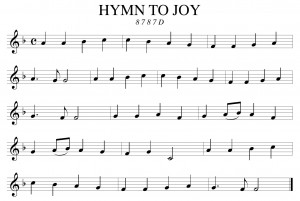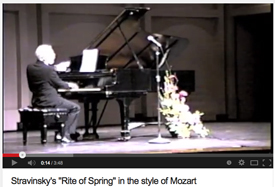For me, there is nothing quite like creating something on the spot and then having someone walk up and ask who wrote the piece I just played. This can be even more amazing to me if the person starts speculating that it might have been one of the great composers: Bach, Mendelssohn, Frank, or even Messiaen. When the person learns it was an improvisation, they often offer up some expression of disbelief. Has this ever happened to you? I’d love to hear your stories about people’s reactions.
While imitation may be the sincerest form of flattery, in music it can often be considered trite and artificial. How many of us have heard stories of assorted different themes being placed into Widor’s Toccata? As I never have actually learned the original, I can’t say that I’ve made the substitution there…. Regardless, I do think it can be a worthwhile skill to imitate other composers using either similar or new thematic material.
Much of my improvisation formation has been focused on learning to create my own style. Very little time was spent focusing on the style of any particular composer. While there are organists that improvise in different styles around, I feel like the current expectation is that to create music, even on demand, requires one to say something original. Treating a theme in the style of some other known composer even when well done seems to have the reputation of a party trick rather than a true skill.
Regardless of the reputation, I believe imitating well known composers is a valid avenue to learning the skills of improvisation. Recently I discovered a couple of pianists that improvise in the style of various classical composers. Jean-Jacques Hauser alias Tartarov debuted at the Tonhalle in Zurich in 1968 with improvisations in the style of Beethoven, Mozart and Liszt. Richard Grayson would take suggestions from the audience for both theme and subject before concluding his concerts with an improvisation. There are extensive collections of both available for viewing on YouTube. I, myself, got caught in a YouTube spiral when I found Grayson’s channel here. I’ve only just begun to explore Tartarov’s channel here. To get you started, I’ve included links for a video from each of them below. Let me know which one is your favorite!
Are there any composers that you are able to imitate well? How did you learn the style? Which composers would you like to be able to imitate? Your feedback will help me flesh out the website and will guide me in the resources I seek out or create.
Hoping your improvs sound like written pieces!
Glenn Osborne
Newsletter Issue 1 – 2014 04 21
See the complete list of past newsletter issues here.
Sign up to receive future issues using the box to the right on this page.
 The melody of the final movement of Ludwig van Beethoven’s final symphony, Symphony No. 9, is often associated with the English text “Joyful, Joyful We Adore Thee” written by Henry van Dyke in 1907. Beethoven originally used portions of a poem by Friedrich Schiller (“Ode an die Freude”, first line: “Freude, schöner Götterfunken”). Beethoven’s tune (without Schiller’s words) was adopted as the Anthem of Europe by the Council of Europe in 1972, and subsequently the European Union.
The melody of the final movement of Ludwig van Beethoven’s final symphony, Symphony No. 9, is often associated with the English text “Joyful, Joyful We Adore Thee” written by Henry van Dyke in 1907. Beethoven originally used portions of a poem by Friedrich Schiller (“Ode an die Freude”, first line: “Freude, schöner Götterfunken”). Beethoven’s tune (without Schiller’s words) was adopted as the Anthem of Europe by the Council of Europe in 1972, and subsequently the European Union.


